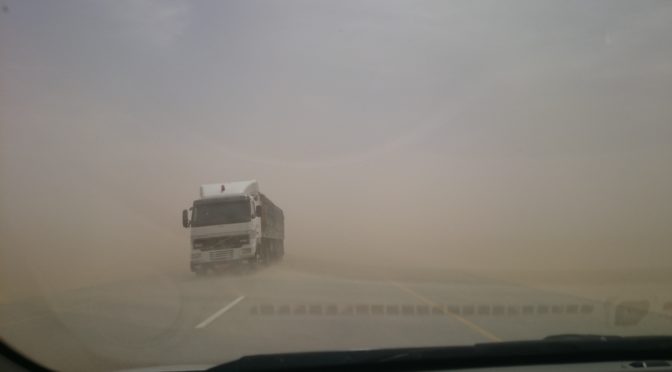In East Africa, including Kenya, the presence of a La Niῆa produces drought. El Niῆo, the ‘Christ Child” was a term coined by Peruvians who would sometimes experience torrential rains beginning around Christmas time in Peru. La Niῆa, “the girl child” is the flip side of an El Niῆo and generally produces the opposite effects. So in Peru, if a La Niῆa follows an El Niῆo, they can expect a prolonged period of drought.
Scientists have determined that both and its sister La Niῆa have global implications for weather patterns affecting each of the 7 continents. They are caused by a shift in Pacific Ocean currents causing up-welling or down-welling of cold and warm waters.
Due to the strong El Niῆo of 2016, ad based on historical records of El Niῆo strength, there is some likelihood that the La Niῆa will continue for the Short Rains of 2017 and Long Rains of 2018, making this a historic 2-year drought.

Figure 1 Red spikes indicate El Nino events, whereas blue troughs indicate La Nina events. Severity increases with greater departures of standard deviation.[1]
Historically La Niῆas have lasted longer than El Niῆos as can be seen in the Multivariate ENSO Index above. Also in general, the stronger the El Niῆo, the stronger the follow-on La Niῆa will be. Therefore, with a historically strong El Niῆo in 2015 – 2016, there is a reasonable likelihood of a moderate to strong La Niῆa which could last up to two successive years.
The currently evolving El Nino situation latest predictions (September 2016) predict sustained drought conditions during the Short Rains of 2016 and Long Rains of 2017[2]; and 2) the knowledge that seasonally even in good years, livestock in pastoral areas of Kenya lose significant amounts of weight making them less valuable, prone to disease with attendant increases in mortality.
During droughts, estimates are that losses are 14% – 86% of livestock herds resulting in significant market value losses, wasted productivity, and increasing the overall methane emissions per kg of meat produced in pastoral areas.[1],[2],[3]
We propose to link viable and sustainable export markets with drought stricken pastoral livestock to enable pastoralists to
1) Receive much-needed cash for their emaciated male livestock before they die;
2) Reduce pastoral core herd size to contain reproductive females to quickly rebuild their herds post-drought and increasing the chances of survival of the remaining livestock through more feed availability per head;
3) Purchase livestock feed from the income for selling their livestock to support their remaining herd, in particular the reproductive age females and young stock.
4) Partner with the Livestock and Meat Exporters Association to place their core stock of valued females in Association feeding centers where they can be fed through the drought, returned to their owners who are then obligated to sell the Association members the males subsequently born stock for an agreed period of time.
A public-private approach
Livestock traders including exporters generally act as resource harvesters. They purchase livestock from pastoralists and then, quickly slaughter them for export or the local market. Seasonally livestock condition deteriorates during the two dry seasons making livestock export trade difficult, since the quality is often too poor for export.
When drought conditions exist, conditions are worse and traders see alternative supplies from as far away as Tanzania and Somalia, though often these attempts fail and they are forced to halt or greatly reduce trading. This is particularly true for the export market as importers are more demanding in terms of quality than local market buyers in Kenya.
Livestock traders like farmers and ranchers are risk adverse by nature, and thus are hesitant to invest in new ventures or approaches, unless they’ve witnessed a working model.
Therefore, our approach is to begin with development partner and project support and then we are confident that the private sector will expand this approach eventually making a very positive impact on pastoral livestock producers.
Additionally, livestock traders will see the benefit of innovative feeding solutions which will enable them to obtain a reliable supply of consistent quality for their domestic and export markets throughout the year, regardless of drought conditions or not.
www.lts-livestocktradeservices.com
[1] Multivariate ENSO Index (MEI). Earth Systems Research Laboratory. NOAA. 2016. http://www.esrl.noaa.gov/psd/enso/mei/
[2] Kenya Meteorological Department KMD/FCSD/5-2016/SO/03. September 5, 2016. http://www.meteo.go.ke/pdf/seasonal.pdf
[3] Drought and recovery: Livestock dynamics among the Ngisonyoka Turkana of Kenya. Human Ecology December 1987, Volume 15, Issue 4, pp 371–389. http://link.springer.com/article/10.1007/BF00887997
[4] The effect of multiple droughts on cattle in Obbu, Northern Kenya. Journal of Arid Environments Volume 49, Issue 2, October 2001, Pages 375-386. http://www.sciencedirect.com/science/article/pii/S0140196300907857
[5 Mobility and livestock mortality in communally used pastoral areas: the impact of the 2005-2006 drought on livestock mortality in Maasailand. David Nkedianye Email author, Jan de Leeuw, Joseph O Ogutu, Mohammed Y Said, Terra L Saidimu, Shem C Kifugo, Dickson S Kaelo and Robin S Reid. Pastoralism: Research, Policy and Practice 20111:17. DOI: 10.1186/2041-7136-1-17 http://pastoralismjournal.springeropen.com/articles/10.1186/2041-7136-1-17

